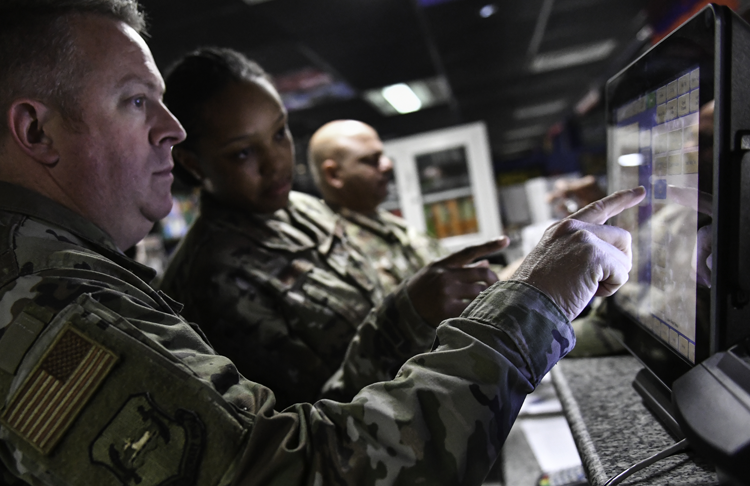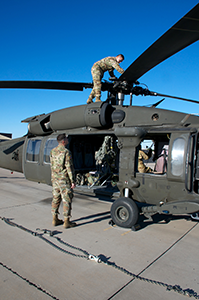Maximum Efficiency, Maximum Gain
Why the Joint Common Foundation (JCF) is Critical to Rapidly Building an AI-Ready Force.
- By: The JAIC
 Source: DVIDS
Source: DVIDS When reading about the DoD’s efforts to accelerate the development of artificial intelligence capabilities through the Joint Artificial Intelligence Center (JAIC), it’s easy to get confused by the organization’s various subcomponents, such as Mission Initiatives and the Joint Common Foundation.
All of these components, though, are carefully designed to work together while making it easier for anyone within the Department of Defense in need of Artificial Intelligence/Machine Learning capabilities to develop their required products as efficiently as possible.

AI makes its way to MacDill dermatology clinic
Source: DVIDS
The MIs are an exciting and high-profile aspect of the JAIC’s operations. These projects are focused on developing AI capabilities that address high-priority operational and business reform challenges that impact entities across all DoD and military organizations. Such challenges include everything from frontline concerns— which are being addressed by the Joint Warfighting, Warfighter Health, and Humanitarian Assistance and Disaster Relief MIs - to the critical behind-the-scenes support needs being worked on by the Predictive Maintenance, Intelligent Business Automation, Augmentation, and Analytics, and Cyber MIs.
In short order, though, these MIs - as well as future ones - will build all of their AI-enabled applications and models within the Joint Common Foundation. In simple terms, the JCF is the framework underlying the JAIC’s mission and, as such, it is critical to jumpstarting and expanding the DoD’s AI capabilities. When it becomes fully operational, the JCF will provide the secure development, test, and runtime environment, as well as the tools, reusable assets, and data libraries, that developers need to rapidly and securely build, refine, test, and field AI applications at scale across the DoD.
“One of the challenges is that whenever there’s an AI project or capability that is being developed within the DoD, organizations must first build an environment, purchase the tools and the software, put those into the environment, and then – finally - start developing their AI/ML capabilities,” explains Army Colonel Sang D. Han, the JCF’s Chief of Infrastructure and Platform. “So if you multiply that by 10 or 15 or 20 different projects, you can see that people are investing a lot to create disparate environments and may even be procuring tools that have already been purchased by others. It’s highly redundant and slow.”
With the JCF, DoD components will instead have access to a ready-to-use, fully authorized AI platform that is almost plug and play, according to Colonel Han. This will ultimately break down barriers to AI entry and accelerate the delivery of AI capabilities to the warfighter.
“If anyone has an AI/ML product that they need to develop, they can come to the JCF and we’ll already have the environment, the tools, and all the other resources available and ready to go,” said Colonel Han. “All you have to do is get an account and you can start. And that will help you cut the time needed to build and deliver those capabilities.”
The value of the JCF extends beyond time and money savings. In fact, the benefits will only expand as DoD developers build their AI products inside of the JCF. DoD developers will be able to:
- Consult and work with cross-functional support teams made up of JAIC personnel and other subject matter experts from the DoD, academia, and industry on a rotational basis.
- Access AI tools, pre-packaged software, code repositories, AI product services, AI data sets and services, Development, Security, and Operations (DevSecOps) best practices, continuous integration/continuous delivery (CI/CD) pipelines, and other resources.
- Leverage and build upon the success and work of any AI development being conducted within the JCF.

Source: DVIDS
As a result, any standards, processes, systems, and best practices developed within the JCF will be repeatable for other AI projects, providing an exponential increase in productivity and mission enhancement over time and allowing the DoD to deploy AI capabilities more rapidly and at scale.
“We will have the tools available that developers need when they bring their projects in, as well as any other resources they need, but if we don’t have the specific tool that they need, we can immediately start the process to bring that tool in,” said Colonel Han. “This will provide project developers the resources they need while setting the foundation for other developers when they have need of that specific tool. That will allow us to develop capabilities at a much larger scale and reduce the time and resources needed to develop AI and get it out to the DoD where it’s needed.”